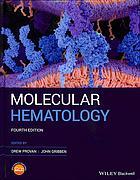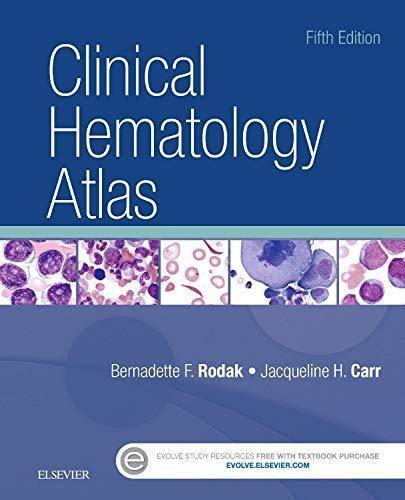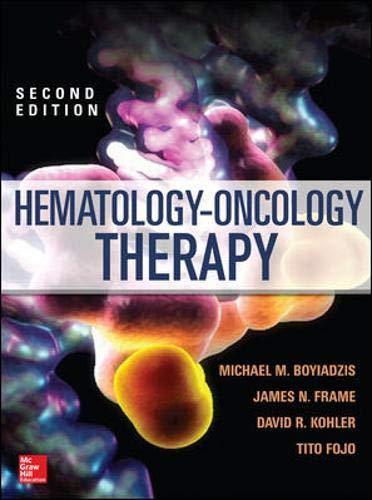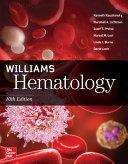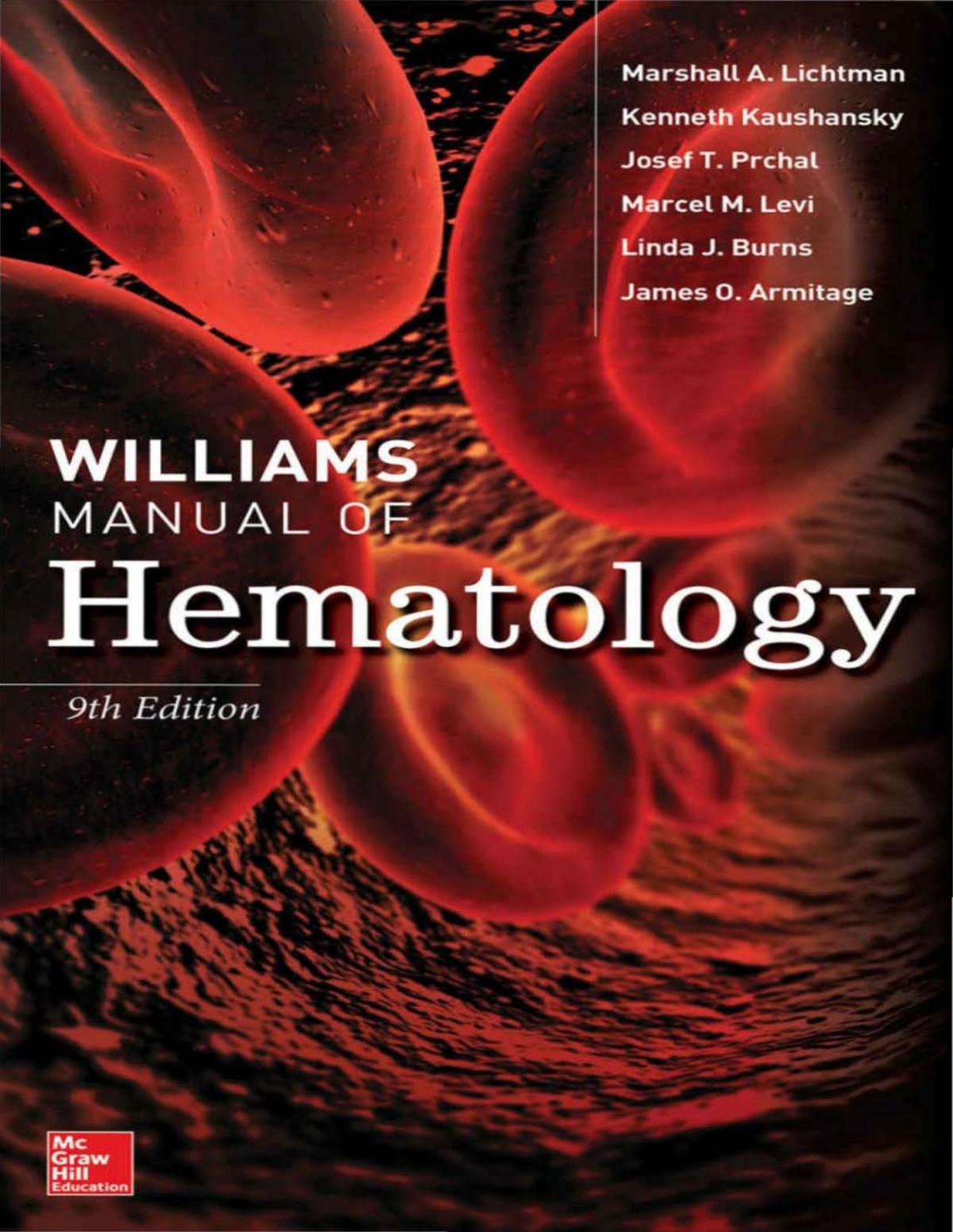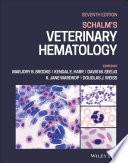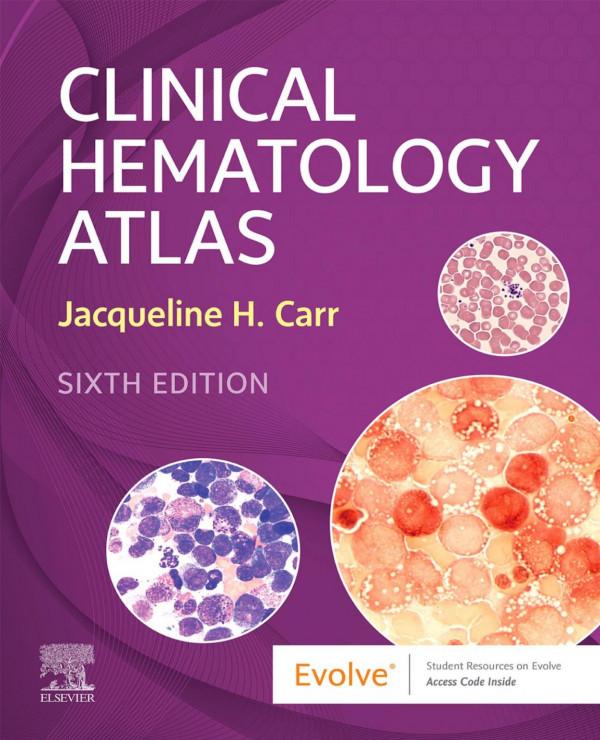Dedication
Wewouldliketodedicatethisbooktotwopeople:ourdearfriendandcolleague,ProfessorSirDavidWeatherall,whosadly passedawayon8December2018.Hewastrulyapioneerofmolecularbiologyandwasthefirstphysicianscientisttouse moleculartechniquestostudyhematologicaldisease.Wewillallmisshimverymuch. Inaddition,wewouldliketodedicatethebooktoValProvan.Alwaysinourthoughtsandmuchmissed.
Contents
Contributors, ix
Prefacetothefourthedition, xiii
Furtherreading, xv
Acknowledgments, xvi
1Beginnings:themolecularpathologyofhemoglobin, 1 DavidWeatherall
2Stemcells, 21 DavidT.Scadden
3Thegeneticsofacutemyeloidleukemias, 37 AmyM.Trottier&CarolynJ.Owen
4Moleculardiagnosticsandriskassessmentin myeloidmalignancies, 49 ChristianScharenberg&TorstenHaferlach
5Molecularbasisofacutelymphoblasticleukemia, 59 BelaPatel&FionaFernando
6Chronicmyeloidleukemia, 71 HagopKantarjian,JorgeCortes,EliasJabbour& SusanO’Brien
7Myeloproliferativeneoplasms, 87 JyotiNangalia,AnthonyJ.Bench,AnthonyR. Green&AnnaL.Godfrey
8Lymphomagenetics, 101 JenniferL.Crombie,AnthonyLetai&JohnG.Gribben
9Themolecularbiologyofchroniclymphocytic leukemia, 111 JohnG.Gribben
10Themolecularbiologyofmultiplemyeloma, 121 WeeJooChng&P.LeifBergsagel
11Themolecularbasisofbonemarrowfailure syndromesandredcellenzymopathies, 131 DeenaIskander,LucioLuzzatto&Anastasios Karadimitris
12Anemiaofchronicdisease, 155 TomasGanz
13Themolecularbasisofironmetabolism, 161 NancyC.Andrews&TomasGanz
14Hemoglobinopathiesduetostructuralmutations, 173 D.MarkLayton&StevenOkoli
15Molecularpathogenesisofmalaria, 193 DavidJ.Roberts,ArnabPain&ChetanE.Chitnis
16Molecularcoagulationandthrombophilia, 207 BjornDahlback&AndreasHillarp
17Themolecularbasisofhemophilia, 221 DanielP.Hart&PaulL.F.Giangrande
18ThemolecularbasisofvonWillebranddisease, 235 LucianoBaronciani
19Plateletdisorders, 251 KennethJ.Clemetson
20Themolecularbasisofbloodcellalloantigens, 267 CristinaNavarrete,LouiseTilley,WinnieChong &ColinJ.Brown
21Functionsofbloodgroupantigens, 285 JonathanS.Stamler&MarilynJ.Telen
22Autoimmunehematologicaldisorders, 297 DrewProvan&JohnW.Semple
23Moleculartherapeuticsinhematology:gene therapy, 319 WilliamM.McKillop&JeffreyA.Medin
24Pharmacogenomics, 339 LeoKager&WilliamE.Evans
25Historyanddevelopmentofmolecularbiology, 353 PaulMoss
26Cancerstemcells, 363 SaraAli&DominiqueBonnet
27Molecularbasisoftransplantation, 373 FrancescoDazzi&AntonioGalleu
Index,389
Contributors
SaraAliMD
HaematopoieticStemCellLaboratory,TheFrancisCrick Institute,London,UK
NancyC.AndrewsMD,PhD DukeUniversitySchoolofMedicine,Durham,NC,USA
LucianoBaroncianiPhD
FondazioneIRCCSCa’GrandaOspedaleMaggiorePoliclinico,AngeloBianchiBonomiHemophiliaandThrombosis Center,Milan,Italy
AnthonyJ.BenchMA,PhD LaboratoryMedicine,NHSLothian,Edinburgh,UK
P.LeifBergsagelMD
DivisionofHematology-Oncology,ComprehensiveCancer Center,MayoClinicArizona,Scottsdale,AZ,USA
DominiqueBonnetPhD
HaematopoieticStemCellLaboratory,TheFrancisCrick Institute,London,UK
ColinJ.BrownPhD,FRCPath
HistocompatibilityandImmunogeneticsLaboratory,NHS BloodandTransplant;FacultyofLifeSciences&Medicine, King’sCollegeLondon,London,UK
ChetanE.ChitnisMSc,MA,PhD MalariaGroup,PasteurInstitute,Paris,France
WeeJooChngMBChB,MRCP,FRCPath
NationalUniversityCancerInstitute,NationalUniversityHealthSystemofSingapore;UniversityofSingapore, NationalUniversityHospital,Singapore
WinnieChongPhD
HistocompatibilityandImmunogeneticsServiceDevelopmentLaboratory,NHSBloodandTransplant,London,UK
KennethJ.ClemetsonPhD,ScD,CChem,FRSC DepartmentofHaematology,Inselspital,UniversityofBerne, Berne,Switzerland
JorgeCortesMD
DepartmentofLeukemia,UniversityofTexasMDAnderson CancerCenter,Houston,TX,USA
JenniferL.CrombieMD
DepartmentofMedicalOncology,Dana-FarberCancer Institute,HarvardMedicalSchool,Boston,MA,USA
Bj ¨ ornDahlb ¨ ackMD,PhD DepartmentofTranslationalMedicine,SectionofClinical Chemistry,LundUniversity,UniversityHospital,Malmo, Sweden
FrancescoDazziMD,PhD
SchoolofCancer&PharmaceuticalSciences,King’sCollege London;King’sHealthPartnersCancerResearchUKCentre, London,UK
WilliamE.EvansPharmD
StJudeChildren’sResearchHospital,Memphis,TN,USA
FionaFernandoMD
CentreofHaemato-Oncology,BartsCancerInstitute,Queen MaryUniversityofLondon,London,UK
AntonioGalleuMD,PhD
SchoolofCancer&PharmaceuticalSciences,King’sCollege London;King’sHealthPartnersCancerResearchUKCentre, London,UK
TomasGanzPhD,MD
DepartmentofMedicine,DavidGeffenSchoolofMedicine atUCLA,LosAngeles,CA,USA
PaulL.F.GiangrandeMD,FRCP,FRCPath,FRCPCH
FormerlyofOxfordHaemophiliaandThrombosisCentre, ChurchillHospital,Oxford,UK
AnnaL.GodfreyPhD,MRCP,FRCPath DepartmentofHaematology,CambridgeUniversityHospitalsNHSFoundationTrust,Cambridge,UK
AnthonyR.GreenPhD,FRCP,FRCPath,FMedSci DepartmentofHaematology,CambridgeInstituteforMedicalResearch;WellcomeMedicalResearchCouncilStemCell Institute,Cambridge,UK
JohnG.GribbenMD,DSc,FRCP,FRCPath,FMedSci BartsCancerInstitute,BartsandTheLondonSchoolof MedicineandDentistry,QueenMaryUniversityofLondon, London,UK
TorstenHaferlachMD
MLLMunichLeukemiaLaboratory,Munich,Germany
DanielP.HartFRCP,FRCPath,PhD
TheRoyalLondonHospitalHaemophiliaCentre,Bartsand TheLondonSchoolofMedicineandDentistry,QueenMary UniversityofLondon,London,UK
AndreasHillarpPhD
DepartmentofClinicalChemistryandTransfusion Medicine,HallandCountyHospital,Halmstad,Sweden
DeenaIskanderMD,PhD,MRCP CentreforHaematology,ImperialCollegeLondon,HammersmithHospital,London,UK
EliasJabbourMD
DepartmentofLeukemia,UniversityofTexasMDAnderson CancerCenter,Houston,TX,USA
LeoKagerMD
DepartmentofPediatrics,St.AnnaChildren’sHospital, MedicalUniversityVienna,Austria
HagopKantarjianMD DepartmentofLeukemia,UniversityofTexasMDAnderson CancerCenter,Houston,TX,USA
AnastasiosKaradimitrisPhD,MRCP,FRCPath DepartmentofHaematologyandBloodTransfusion, MuhimbiliUniversityCollegeofHealthSciences,Dar-esSalaam,Tanzania
D.MarkLaytonMBBS,FRCP,FRCPCH CenterforHematology,ImperialCollegeLondon,London, UK
AnthonyLetaiMD,PhD DepartmentofMedicalOncology,Dana-FarberCancer Institute,HarvardMedicalSchool,Boston,MA,USA
LucioLuzzattoMD DepartmentofHaematologyandBloodTransfusion, MuhimbiliUniversityCollegeofHealthSciences,Dar-esSalaam,Tanzania
WilliamM.McKillopPhD DepartmentofPediatrics,MedicalCollegeofWisconsin, Milwaukee,WI,USA
JeffreyA.MedinPhD DepartmentsofPediatricsandBiochemistry,MedicalCollegeofWisconsin,Milwaukee,WI,USA
PaulMossMD,PhD SchoolofCancerSciences,UniversityofBirmingham,Birmingham,UK
JyotiNangaliaPhD,MRCP,FRCPath WelcomeSangerInstitute,Hinxton;DepartmentofHaematology,UniversityofCambridge;Wellcome-Medical ResearchCouncilCambridgeStemCellInstitute,Cambridge,UK
CristinaNavarretePhD,FRCPath HistocompatibilityandImmunogeneticsServiceDevelopmentDepartment,NHSBloodandTransplant;Department ofImmunologyandMolecularPathology,UniversityCollege London,London,UK
SusanO’BrienMD DepartmentofLeukemia,UniversityofTexasMDAnderson CancerCenter,Houston,TX,USA
StevenOkoliMBChB,FRCP,FRCPath CenterforHematology,ImperialCollegeLondon,London, UK
CarolynJ.OwenMD,MDres(UK),FRCPC DivisionofHematologyandHematologicalMalignancies, UniversityofCalgary,FoothillsMedicalCentre,Calgary, Canada
ArnabPainPhD BiologicalandEnvironmentalSciencesandEngineering (BESE)Division,KingAbdullahUniversityofScienceand Technology,Jeddah,SaudiArabia;NuffieldDivisionofClinicalLaboratorySciences(NDCLS),TheJohnRadcliffeHospital,UniversityofOxford,Headington,Oxford,UK
BelaPatelMD,FRCPath,MD(res) CentreofHaemato-Oncology,BartsCancerInstitute,Queen MaryUniversityofLondon,London,UK
DrewProvanMD,FRCP,FRCPath BlizardInstitute,BartsandTheLondonSchoolofMedicine andDentistry,QueenMaryUniversityofLondon,London, UK
DavidJ.RobertsDPhil,MRCP,FRCPath NationalHealthServiceBloodandTransplant(Oxford),The JohnRadcliffeHospital,Oxford,UK
DavidT.ScaddenMD DepartmentofStemCellandRegenerativeBiology,Harvard StemCellInstitute,HarvardUniversity;CenterforRegenerativeMedicine,MassachusettsGeneralHospital,Boston,MA, USA
ChristianScharenbergMD,PhD DepartmentofHematology,SkaraborgsHospital,Skovde; DepartmentofCellandMolecularBiology,KarolinskaInstitute,Stockholm,Sweden
JohnW.SemplePhD DivisionofHematologyandTransfusionMedicine,Lund University,Lund,Sweden
JonathanS.StamlerMD
HarringtonDiscoveryInstituteandInstituteofTransformativeMolecularMedicine,UniversityHospitalsCleveland MedicalCenterandCaseWesternReserveUniversity,Cleveland,OH,USA
MarilynJ.TelenMD DepartmentofMedicine,DivisionofHematology,Duke UniversityMedicalCenter,Durham,NC,USA
LouiseTilleyPhD
InternationalBloodGroupReferenceLaboratory,NHS BloodandTransplant,Bristol,UK
AmyM.TrottierMSc,MD,FRCPC DivisionofHematologyandHematologicalMalignancies, UniversityofCalgary,FoothillsMedicalCentre,Calgary, Canada
DavidWeatherallMD,FRCP,FRS FormerlyofWeatherallInstituteofMolecularMedicine,The JohnRadcliffeHospital,Oxford,UK
Chapter1 Beginnings:themolecular pathologyofhemoglobin
DavidWeatherall
WeatherallInstituteofMolecularMedicine,JohnRadcliffeHospital,Oxford,UK
Historicalbackground, 1
Thestructure,geneticcontrol,andsynthesisofnormalhemoglobin, 2
Themolecularpathologyofhemoglobin, 6
Genotype–phenotyperelationshipsinthethalassemias, 12
Structuralhemoglobinvariants, 16
Historicalbackground
LinusPaulingfirstusedtheterm“moleculardisease”in1949, afterthediscoverythatthestructureofsicklecellhemoglobin differedfromthatofnormalhemoglobin.Indeed,itwasthis seminalobservationthatledtotheconceptof molecular medicine,thedescriptionofdiseasemechanismsatthelevel ofcellsandmolecules.However,untilthedevelopmentof recombinantDNAtechnologyinthemid-1970s,knowledge ofeventsinsidethecellnucleus,notablyhowgenesfunction, couldonlybethesubjectofguessworkbasedonthestructure andfunctionoftheirproteinproducts.However,assoonas itbecamepossibletoisolatehumangenesandtostudytheir properties,thepicturechangeddramatically.
Progressoverthelast30yearshasbeendrivenbytechnologicaladvancesinmolecularbiology.Atfirstitwaspossible onlytoobtainindirectinformationaboutthestructureand functionofgenesbyDNA/DNAandDNA/RNAhybridization;thatis,byprobingthequantityorstructureofRNA orDNAbyannealingreactionswithmolecularprobes.The nextmajoradvancewastheabilitytofractionateDNAinto piecesofpredictablesizewithbacterialrestrictionenzymes. Thisledtotheinventionofatechniquethatplayedacentral roleintheearlydevelopmentofhumanmoleculargenetics, called Southernblotting afterthenameofitsdeveloper,Edwin Southern.Thismethodallowedthestructureandorganizationofgenestobestudieddirectlyforthefirsttimeandled tothedefinitionofanumberofdifferentformsofmolecular pathology.
OnceitwaspossibletofractionateDNA,itsoonbecame feasibletoinsertthepiecesintovectorsabletodivide
Molecularaspectsofthehighfrequencyofthehemoglobinvariants, 17
Molecularaspectsofthepreventionandmanagementofthe hemoglobindisorders, 18
Postscript, 18
Furtherreading, 18
withinbacteria.Thesteadyimprovementinthepropertiesofcloningvectorsmadeitpossibletogeneratelibraries ofhumanDNAgrowinginbacterialcultures.Ingenious approachesweredevelopedtoscanthelibrariestodetect genesofinterest;oncepinpointed,theappropriatebacterialcoloniescouldbegrowntogeneratelargerquantitiesof DNAcarryingaparticulargene.Lateritbecamepossible tosequencethesegenes,persuadethemtosynthesizetheir productsinmicroorganisms,culturedcells,orevenother species,andhencetodefinetheirkeyregulatoryregions.
Theearlyworkinthefieldofhumanmoleculargeneticsfocusedondiseasesinwhichtherewassomeknowledgeofthegeneticdefectattheproteinorbiochemicallevel. However,oncelinkagemapsofthehumangenomebecame available,followingtheidentificationofhighlypolymorphic regionsofDNA,itwaspossibletosearchforanygenefora disease,evenwherethecausewascompletelyunknown.This approach,firstcalled reversegenetics andlaterrechristened positionalcloning,ledtothediscoveryofgenesformany importantdiseases.
Asmethodsforsequencingwereimprovedandautomated, thoughtsturnedtothenextmajorgoalinthisfield,whichwas todeterminethecompletesequenceofthebasesthatconstituteourgenesandallthatliesbetweenthem:theHuman GenomeProject.Thisremarkableendeavorwasfinallycompletedin2006.Thefurtherunderstandingofthefunctions andregulationofourgeneswillrequiremultidisciplinary researchencompassingmanydifferentfields.Thenextstage intheHumanGenomeProject,called genomeannotation, entailsanalyzingtherawDNAsequenceinordertodetermineitsbiologicalsignificance.Oneofthemainventures intheeraoffunctionalgenomicswillbeinwhatistermed proteomics,thelarge-scaleanalysisoftheproteinproductsof genes.Theultimategoalwillbetotrytodefinetheprotein
complement,orproteome,ofcellsandhowthemanydifferentproteinsinteractwithoneanother.Tothisend,largescalefacilitiesarebeingestablishedforisolatingandpurifyingtheproteinproductsofgenesthathavebeenexpressed inbacteria.Theirstructurecanthenbestudiedbyavarietyofdifferenttechniques,notablyX-raycrystallography andnuclearmagneticresonancespectroscopy.Thecrystallographicanalysisofproteinsisbeinggreatlyfacilitated bytheuseofX-raybeamsfromasynchrotronradiation source.
Inthelastfewyearsboththeutilityandextremecomplexityofthefruitsofthegenomeprojecthavebecome apparent.Theexistenceofthousandsofsingle-nucleotide polymorphisms(SNPs)hasmadeitpossibletosearchfor genesofbiologicalormedicalsignificance.Thediscoveryof familiesofregulatoryRNAsandproteinsisstartingtoshed lightonhowthefunctionsofthegenomearecontrolled, andstudiesofacquiredchangesinitsstructure, epigenetics, promisetoprovidesimilarinformation.Recentdevelopmentsinnew-generationsequencingofDNAandRNAare alsoprovidinginvaluableinformationaboutmanyaspects ofgeneregulation.
Duringthisremarkableperiodoftechnicaladvance,considerableprogresshasbeenmadetowardanunderstanding ofthepathologyofdiseaseatthemolecularlevel.Thishas hadaparticularimpactonhematology,leadingtoadvances intheunderstandingofgenefunctionanddiseasemechanismsinalmosteveryaspectofthefield.
Theinheriteddisordersofhemoglobin–thethalassemias andstructuralhemoglobinvariants,thecommonesthuman monogenicdiseases–werethefirsttobestudiedsystematicallyatthemolecularlevelandagreatdealisknownabout theirgenotype–phenotyperelationships.Thisfieldledthe waytomolecularhematologyand,indeed,tothedevelopmentofmolecularmedicine.Thus,eventhoughthegeneticsofhemoglobiniscomplicatedbythefactthatdifferent varietiesareproducedatparticularstagesofhumandevelopment,themolecularpathologyofthehemoglobinopathies providesanexcellentmodelsystemforunderstandingany monogenicdiseaseandthecomplexinteractionsbetween genotypeandenvironmentthatunderliemanymultigenic disorders.
InthischapterIconsiderthestructure,synthesis,and geneticcontrolofthehumanhemoglobins,describethe molecularpathologyofthethalassemias,anddiscussbriefly howthecomplexinteractionsoftheirdifferentgenotypes producearemarkablydiversefamilyofclinicalphenotypes; thestructuralhemoglobinvariantsarediscussedinmore detailinChapter14.Readerswhowishtolearnmoreabout themethodsofmoleculargenetics,particularlyasappliedto thestudyofhemoglobindisorders,arereferredtothereviews citedattheendofthischapter.
Thestructure,geneticcontrol,and synthesisofnormalhemoglobin
Structureandfunction
Thevaryingoxygenrequirementsduringembryonic,fetal, andadultlifearereflectedinthesynthesisofdifferent structuralhemoglobinsateachstageofhumandevelopment. However,theyallhavethesamegeneraltetramericstructure,consistingoftwodifferentpairsofglobinchains,each attachedtoonehememolecule.Adultandfetalhemoglobins have α chainscombinedwith β chains(HbA, α2 β2 ), δ chains(HbA2 , α2 δ2 ),and γ chains(HbF, α2 γ2 ).In embryos, α-likechainscalled ζ chainscombinewith γ chainstoproduceHbPortland(ζ2 γ2 ),orwith ε chainsto makeHbGower1(ζ2 ε2 ),while α and ε chainsformHb Gower2(α2 ε2 ).Fetalhemoglobinisheterogeneous;there aretwovarietiesof γ chainthatdifferonlyintheiramino acidcompositionatposition136,whichmaybeoccupiedby eitherglycineoralanine; γ chainscontainingglycineatthis positionarecalled G γ chains,thosewithalanine A γ chains (Figure1.1).
Thesynthesisofhemoglobintetramersconsistingoftwo unlikepairsofglobinchainsisabsolutelyessentialforthe effectivefunctionofhemoglobinasanoxygencarrier.The classicalsigmoidshapeoftheoxygendissociationcurve, whichreflectstheallostericpropertiesofthehemoglobin molecule,ensuresthat,athighoxygentensionsinthelungs, oxygenisreadilytakenupandlaterreleasedeffectivelyatthe lowertensionsencounteredinthetissues.Theshapeofthe curveisquitedifferenttothatofmyoglobin,amoleculethat consistsofasingleglobinchainwithhemeattachedtoit, which,likeabnormalhemoglobinsthatconsistofhomotetramersoflikechains,hasahyperbolicoxygendissociation curve.
Thetransitionfromahyperbolictoasigmoidoxygen dissociationcurve,whichisabsolutelycriticalfornormal oxygendelivery,reflectscooperativitybetweenthefour hememoleculesandtheirglobinsubunits.Whenoneof themtakesonoxygen,theaffinityoftheremainingthree increasesmarkedly;thishappensbecausehemoglobincan existintwoconfigurations,deoxy(T)andoxy(R),whereT andRrepresentthetightandrelaxedstates,respectively. TheTconfigurationhasaloweraffinitythantheRfor ligandssuchasoxygen.Atsomepointduringtheaddition ofoxygentothehemes,thetransitionfromtheTtotheR configurationoccursandtheoxygenaffinityofthepartially ligandedmoleculeincreasesdramatically.Theseallosteric changesresultfrominteractionsbetweentheironofthe hemegroupsandvariousbondswithinthehemoglobin tetramer,whichleadtosubtlespatialchangesasoxygenis takenonorgivenup.
Embryo
Fetus
Adult
Fig.1.1Thegeneticcontrolofhumanhemoglobinproductioninembryonic,fetal,andadultlife. Thestandardnamesforthesegenes areasfollows:Alphagenes HBA1 and HBA2,Betagene HBB,Gammagenes HBG1 and HBG2,Deltagene HBD,andtheembryonicgenes HBE1 and HBZ
Theprecisetetramericstructuresofthedifferenthuman hemoglobins,whichreflecttheprimaryaminoacid sequencesoftheirindividualglobinchains,arealsovital forthevariousadaptivechangesthatarerequiredtoensure adequatetissueoxygenation.Thepositionoftheoxygen dissociationcurvecanbemodifiedinseveralways.For example,oxygenaffinitydecreaseswithincreasingCO2 tension(theBohreffect).Thisfacilitatesoxygenloadingtothe tissues,whereadropinpHduetoCO2 influxlowersoxygen affinity;theoppositeeffectoccursinthelungs.Oxygenaffinityisalsomodifiedbythelevelof2,3-diphosphoglycerate (2,3-BPG)intheredcell.Increasingconcentrationsshift theoxygendissociationcurvetotheright(i.e.theyreduce oxygenaffinity),whilediminishingconcentrationshavethe oppositeeffect.2,3-BPGfitsintothegapbetweenthetwo β chainswhenitwidensduringdeoxygenation,andinteracts withseveralspecificbindingsitesinthecentralcavityof themolecule.Inthedeoxyconfigurationthegapbetween thetwo β chainsnarrowsandthemoleculecannotbe accommodated.Withincreasingconcentrationsof2,3-BPG, whicharefoundinvarioushypoxicandanemicstates, morehemoglobinmoleculestendtobeheldinthedeoxy configurationandtheoxygendissociationcurveistherefore shiftedtotheright,withmoreeffectivereleaseofoxygen.
Fetalredcellshavegreateroxygenaffinitythanadult redcells,although,interestingly,purifiedfetalhemoglobin hasanoxygendissociationcurvesimilartothatofadult hemoglobin.Thesedifferences,whichareadaptedtotheoxygenrequirementsoffetallife,reflecttherelativeinabilityof HbFtointeractwith2,3-BPGcomparedwithHbA.Thisis becausethe γ chainsofHbFlackspecificbindingsitesfor 2,3-BPG.
Inshort,oxygentransportcanbemodifiedbyavariety ofadaptivefeaturesintheredcellthatincludeinteractions betweenthedifferenthememolecules,theeffectsofCO2 ,and differentialaffinitiesfor2,3-BPG.Thesechanges,together withmoregeneralmechanismsinvolvingthecardiorespiratorysystem,providethemainbasisforphysiologicaladaptationtoanemia.
Geneticcontrolofhemoglobin
The α-and β-likeglobinchainsaretheproductsoftwodifferentgenefamilieswhicharefoundondifferentchromosomes(Figure1.1).The β-likeglobingenesformalinked clusteronchromosome11,spreadoverapproximately60kb (kilobaseor1000nucleotidebases).Thedifferentgenesthat formthisclusterarearrangedintheorder5′ –ε–G γ–A γ–ψβ–δ–β–3′ .The α-likegenesalsoformalinkedcluster,in thiscaseonchromosome16,intheorder5′ –ζ–ψζ–ψα1–α2–α1–3′ .The ψβ, ψζ,and ψα genesarepseudogenes;that is,theyhavestrongsequencehomologywiththe β, ζ,and α genes,butcontainanumberofdifferencesthatprevent themfromdirectingthesynthesisofanyproducts.Theymay reflectremnantsofgenesthatwerefunctionalatanearlier stageofhumanevolution.
Thestructureofthehumanglobingenesis,inessence, similartothatofallmammaliangenes.Theyconsistoflong stringsofnucleotidesthataredividedintocodingregions, orexons,andnon-codinginsertscalled interveningsequences (IVSs)orintrons.The β-likeglobingenescontaintwo introns,oneof122–130basepairsbetweencodons30and31 andoneof850–900basepairsbetweencodons104and105 (theexoncodonsarenumberedsequentiallyfromthe5′ to
the3′ endofthegene,i.e.fromlefttoright).Similar,though smaller,intronsarefoundinthe α and ζ globingenes.These intronsandexons,togetherwithshortnon-codingsequences atthe5′ and3′ endsofthegenes,representthemajorfunctionalregionsoftheparticulargenes.However,therearealso extremelyimportantregulatorysequenceswhichsubserve thesefunctionsthatlieoutsidethegenesthemselves.
Atthe5′ non-coding(flanking)regionsoftheglobin genes,asinallmammaliangenes,thereareblocksof nucleotidehomology.Thefirst,theATAbox,isabout30 basesupstream(totheleft)oftheinitiationcodon;thatis,the startwordforthebeginningofproteinsynthesis(seelater). Thesecond,theCCAATbox,isabout70basepairsupstream fromthe5′ endofthegenes.About80–100basesfurther upstreamthereisthesequenceGGGGTG,orCACCC,which maybeinvertedorduplicated.Thesethreehighlyconserved DNAsequences,called promoterelements,areinvolvedin theinitiationoftranscriptionoftheindividualgenes.Finally, inthe3′ non-codingregionofalltheglobingenesthere isthesequenceAATAAA,whichisthesignalforcleavage andpolyAadditiontoRNAtranscripts(seeGeneActionand GlobinSynthesis).
Theglobingeneclustersalsocontainseveralsequences thatconstituteregulatoryelements,whichinteracttopromoteerythroid-specificgeneexpressionandcoordination ofthechangesinglobingeneactivityduringdevelopment.Theseincludetheglobin genesthemselvesandtheir
promoterelements:enhancers(regulatorysequencesthat increasegeneexpressiondespitebeinglocatedataconsiderabledistancefromthegenes)and“master”regulatory sequencescalled,inthecaseofthe β globingenecluster,the locuscontrolregion (LCR)and,inthecaseofthe α genes, HS40(anuclease-hypersensitivesiteinDNA40kbfromthe α globingenes).Eachofthesesequenceshasamodularstructuremadeupofanarrayofshortmotifsthatrepresentthe bindingsitesfortranscriptionalactivatorsorrepressors.
Geneactionandglobinsynthesis
TheflowofinformationbetweenDNAandproteinissummarizedinFigure1.2.Whenaglobingeneistranscribed, messengerRNA(mRNA)issynthesizedfromoneofits strands,aprocesswhichbeginswiththeformationofatranscriptioncomplexconsistingofavarietyofregulatoryproteinstogetherwithanenzymecalledRNApolymerase(see later).TheprimarytranscriptisalargemRNAprecursor whichcontainsbothintronandexonsequences.Whilein thenucleus,thismoleculeundergoesavarietyofmodifications.First,theintronsareremovedandtheexonsarespliced together.Theintron/exonjunctionsalwayshavethesame sequence:GTattheir5′ end,andAGattheir3′ end.This appearstobeessentialforaccuratesplicing;ifthereisamutationatthesesitesthisprocessdoesnotoccur.Splicingreflects acomplexseriesofintermediarystagesandtheinteraction
Fig.1.2
ofanumberofdifferentnuclearproteins.Aftertheexonsare joined,themRNAsaremodifiedandstabilized;attheir5′ end acomplexCAPstructureisformed,whileattheir3′ enda stringofadenylicacidresidues(polyA)isadded.ThemRNA processedinthiswaymovesintothecytoplasm,whereit actsasatemplateforglobinchainproduction.Becauseof therulesofbasepairing–thatis,cytosinealwayspairswith thymine,andguaninewithadenine–thestructureofthe mRNAreflectsafaithfulcopyoftheDNAcodonsfromwhich itissynthesized;theonlydifferenceisthat,inRNA,uracil(U) replacesthymine(T).
AminoacidsaretransportedtothemRNAtemplateon carrierscalledtransferRNAs(tRNAs);therearespecific tRNAsforeachaminoacid.Furthermore,becausethegenetic codeisredundant(i.e.morethanonecodoncanencodea particularaminoacid),forsomeoftheaminoacidsthereare severaldifferentindividualtRNAs.Theirorderintheglobin chainisdeterminedbytheorderofcodonsinthemRNA. ThetRNAscontainthreebases,whichtogetherconstitutean anticodon;theseanticodonsarecomplementarytomRNA codonsforparticularaminoacids.Theycarryaminoacids tothetemplate,wheretheyfindtheappropriatepositioning bycodon–anticodonbasepairing.WhenthefirsttRNAis inposition,aninitiationcomplexisformedbetweenseveral proteininitiationfactorstogetherwiththetwosubunitsthat constitutetheribosomes.AsecondtRNAmovesinalongsideandthetwoaminoacidsthattheyarecarryingform apeptidebondbetweenthem;theglobinchainisnowtwo aminoacidresidueslong.Thisprocessiscontinuedalong
themRNAfromlefttoright,andthegrowingpeptidechain istransferredfromoneincomingtRNAtothenext;thatis, themRNAistranslatedfrom5′ to3′ .Duringthistimethe tRNAsareheldinappropriatestericconfigurationwiththe mRNAbythetworibosomalsubunits.Therearespecific initiation(AUG)andtermination(UAA,UAG,andUGA) codons.Whentheribosomesreachtheterminationcodon, translationceases,thecompletedglobinchainsarereleased, andtheribosomalsubunitsarerecycled.Individualglobin chainscombinewithheme,whichhasbeensynthesized throughaseparatepathway,andtheninteractwithonelike chainandtwounlikechainstoformacompletehemoglobin tetramer.
Regulationofhemoglobinsynthesis
Theregulationofglobingeneexpressionismediatedmainly atthetranscriptionallevel,withsomefinetuningduring translationandpost-translationalmodificationofthegene products.DNAthatisnotinvolvedintranscriptionisheld tightlypackagedinacompact,chemicallymodifiedformthat isinaccessibletotranscriptionfactorsandpolymerasesandis heavilymethylated.Activationofaparticulargeneisreflected bychangesinthestructureofthesurroundingchromatin, whichcanbeidentifiedbyenhancedsensitivitytonucleases. Erythroidlineage-specificnuclease-hypersensitivesitesare foundatseverallocationsinthe β globingenecluster.Four aredistributedover20kbupstreamfromthe ε globingene intheregionofthe β globinLCR(Figure1.3).Thisvital
Chromosome 11
Chromosome 16
Fig.1.3Thepositionsofthemajorregulatoryregionsinthe β and α globingeneclusters. Thearrowsindicatethepositionofthe erythroidlineage-specificnuclease-hypersensitivesites.HS,hypersensitive.
regulatoryregionisabletoestablishatranscriptionallyactive domainspanningtheentire β globingenecluster.Several enhancersequenceshavebeenidentifiedinthiscluster.A varietyofregulatoryproteinsbindtotheLCR,andtothe promoterregionsoftheglobingenesandtotheenhancer sequences.ItisthoughtthattheLCRandotherenhancer regionsbecomeopposedtothepromoterstoincrease therateoftranscriptionofthegenestowhichtheyare related.
Theseregulatoryregionscontainsequencemotifsfor variousubiquitousanderythroid-restrictedtranscription factors.Bindingsitesforthesefactorshavebeenidentifiedin eachoftheglobingenepromotersandatthehypersensitive siteregionsofthevariousregulatoryelements.Anumber ofthefactorswhichbindtotheseareasarefoundinallcell types.TheyincludeSp1,Yy1,andUsf.Incontrast,anumber oftranscriptionfactorshavebeenidentified,including GATA-1,EKLF,andNF-E2,whicharerestrictedintheir distributiontoerythroidcellsand,insomecases,megakaryocytes,andmastcells.Theoverlappingoferythroid-specific andubiquitous-factorbindingsitesinseveralcasessuggests thatcompetitivebindingmayplayanimportantpartin theregulationoferythroid-specificgenes.Anotherbinding factor,SSP,thestageselectorprotein,appearstointeract specificallywith ε and γ genes.Severalelementsinvolving thechromatinandhistoneacetylationrequiredforaccessof theseregulatoryproteinshavebeenidentified.
Thebindingofhematopoietic-specificfactorsactivatesthe LCR,whichrenderstheentire β globingeneclustertranscriptionallyactive.Thesefactorsalsobindtotheenhancer andpromotersequences,whichworkintandemtoregulatetheexpressionoftheindividualgenesintheclusters.It islikelythatsomeofthetranscriptionalfactorsaredevelopmentalstagespecific,andhencemayberesponsiblefor thedifferentialexpressionoftheembryonic,fetal,andadult globingenes.The α globingeneclusteralsocontainsanelement,HS40,whichhassomestructuralfeaturesincommon withthe β LCR,althoughitisdifferentinaspectsofitsstructure.Anumberofenhancer-likesequenceshavebeenidentified,althoughitisbecomingclearthattherearefundamental differencesinthepatternofregulationofthetwoglobingene clusters.
Inadditiontothedifferentregulatorysequencesoutlined, therearealsosequenceswhichmaybeinvolvedspecifically with“silencing”ofgenes,notablythosefortheembryonic hemoglobins,duringdevelopment.
Somedegreeofregulationismediatedbydifferencesin theratesofinitiationandtranslationofthedifferentmRNAs, andatthepost-transcriptionallevelbydifferentialaffinity fordifferentproteinsubunits.However,thiskindofposttranscriptionalfinetuningprobablyplaysarelativelysmall roleindeterminingtheoveralloutputoftheglobingene products.
Regulationofdevelopmentalchanges inglobingeneexpression
Duringdevelopment,thesiteofredcellproductionmoves fromtheyolksactothefetalliverandspleen,andthence tobonemarrowintheadult.Embryonic,fetal,andadult hemoglobinsynthesisisapproximatelyrelatedintimeto thesechangesinthesiteoferythropoiesis,althoughitisquite clearthatthevariousswitches,betweenembryonicandfetal andbetweenfetalandadulthemoglobinsynthesis,arebeautifullysynchronizedthroughoutthesedifferentsites.Fetal hemoglobinsynthesisdeclinesduringthelatermonthsof gestation,andHbFisreplacedbyHbAandHbA2 bythe endofthefirstyearoflife.
Althoughtheexactmechanismoftheswitchfromfetalto adulthemoglobinisstillnotunderstood,recentstudiesof patientswithunusuallyhighlevelsofHbFandgenome-wide associationstudies(GWAS)haveyieldedextremelypromisinginformationaboutsomeoftheregulatorygenesinvolved. TheyincludeBCL11A,MYB,andKLF1.Itisclearfromstudiesoftheseandrelatedgenesthattheyareinvolveddirectlyin theregulationofhemoglobinswitching,workwhichisyieldinggreatpromiseforthedevelopmentoffuturetechnology forincreasingHbFsynthesistomodifythephenotypeofthalassemiasandsicklecellanemia.
Themolecularpathology ofhemoglobin
Asisthecaseformanymonogenicdiseases,theinheriteddisordersofhemoglobinfallintotwomajorclasses.First,there arethosethatresultfromreducedoutputofoneorother globingenes,the thalassemias.Second,thereisawiderange ofconditionsthatresultfromtheproductionof structurally abnormalglobinchains;thetypeofdiseasedependsonhow theparticularalterationinproteinstructureinterfereswith itsstabilityorfunction.Ofcourse,nobiologicalclassificationisentirelysatisfactoryandthosewhichattempttodefine thehemoglobindisordersarenoexception.Therearesome structuralhemoglobinvariantswhichhappentobesynthesizedatareducedrateandhenceareassociatedwithaclinicalpicturesimilartothalassemia.Andthereareotherclasses ofmutationswhichsimplyinterferewiththenormaltransitionfromfetaltoadulthemoglobinsynthesis,afamilyof conditionsgiventhegeneraltitle hereditarypersistenceoffetal hemoglobin (HPFH).Furthermore,becausethesediseasesare allsocommonandoccurtogetherinparticularpopulations, itisnotuncommonforanindividualtoinheritagenefor oneorotherformofthalassemiaandastructuralhemoglobin variant.Theheterogeneousgroupofconditionsthatresults fromthesedifferentmutationsandinteractionsissummarizedinTable1.1.
Table1.1 Thethalassemiasandrelateddisorders
α Thalassemia γ Thalassemia
α0
α+ δ Thalassemia
Deletion( α)
Non-deletion(αT ) εγδβ Thalassemia
β Thalassemia Hereditarypersistenceof β0 fetalhemoglobin
β+ Deletion
NormalHbA2 (δβ)0
“Silent” Non-deletion
Dominant Linkedto β globingenes
δβ Thalassemia G γβ+ (δβ)+A γβ+ (δβ)0 Unlinkedto β globingenes (A γδβ)0
Overrecentyears,determinationofthemolecularpathologyofthetwocommonformsofthalassemia, α and β,has providedaremarkablepictureoftherepertoireofmutations thatcanunderliehumanmonogenicdisease.Inthesections thatfollowIdescribe,inoutline,thedifferentformsofmolecularpathologythatunderlietheseconditions.
The
β thalassemias
Therearetwomainclassesof β thalassemia, β0 thalassemia, inwhichthereisanabsenceof β globinchainproduction, and β+ thalassemia,inwhichthereisavariablereduction intheoutputof β globinchains.AsshowninFigure1.4, mutationsofthe β globingenesmaycauseareducedoutput ofgeneproductattheleveloftranscriptionormRNA processing,ortranslation,orthroughthestabilityofthe globingeneproduct.
Defective β globingenetranscription
Thereareavarietyofmechanismsthatinterferewithnormaltranscriptionofthe β globingenes.First,thegenesmay beeithercompletelyorpartiallydeleted.Overall,deletions ofthe β globingenesarenotcommonlyfoundinpatients with β thalassemia,withoneexception:a619-bpdeletion involvingthe3′ endofthegeneisfoundfrequentlyinthe SindpopulationsofIndiaandPakistan,whereitconstitutes about30%ofthe β thalassemiaalleles.Otherdeletionsare extremelyrare.
Amuchmorecommongroupofmutations,whichresults inamoderatedecreaseintherateoftranscriptionofthe β globingenes,involvessingle-nucleotidesubstitutionsin orneartheTATAboxatabout 30nucleotides(nt)from thetranscriptionstartsite,orintheproximalordistalpromoterelementsat 90and 105nt.Thesemutationsresult indecreased β globinmRNAproduction,rangingfrom10% to25%ofthenormaloutput.Thus,theyareusuallyassociatedwiththemildformsof β+ thalassemia.TheyareparticularlycommoninAfricanpopulations,anobservationwhich explainstheunusualmildnessof β thalassemiainthisracial group.Oneparticularmutation,C → Tatposition 101nt tothe β globingene,causesanextremelymilddeficitof β globinmRNA.Indeed,thisalleleissomildthatitiscompletelysilentincarriersandcanonlybeidentifiedbyitsinteractionwithmoresevere β thalassemiaallelesincompound heterozygotes.
Mutationsthatcauseabnormalprocessing ofmRNA
Asmentionedearlier,theboundariesbetweenexonsand intronsaremarkedbytheinvariantdinucleotidesGTatthe donor(5′ )siteandAGattheacceptor(3′ )site.Mutationsthat affecteitherofthesesitescompletelyabolishnormalsplicing
Point mutations
Fig.1.4Themutationsofthe β globingenethatunderlie β thalassemia. Theheavyblacklinesindicatethelengthofthedeletions.The pointmutationsaredesignatedasfollows:PR,promoter;C,CAPsite;I,initiationcodon;FS,frameshiftandnonsensemutations;SPL,splice mutations;PolyA,polyAadditionsitemutations.
Deletions
andproducethephenotypeof β0 thalassemia.Thetranscriptionofgenescarryingthesemutationsappearstobenormal, butthereiscompleteinactivationofsplicingatthealtered junction.
Anotherfamilyofmutationsinvolveswhatarecalled splice siteconsensussequences.AlthoughonlytheGTdinucleotide isinvariantatthedonorsplicesite,thereisconservation ofadjacentnucleotidesandacommon,orconsensus, sequenceoftheseregionscanbeidentified.Mutations withinthissequencecanreducetheefficiencyofsplicing tovaryingdegrees,becausetheyleadtoalternatesplicing atthesurroundingcrypticsites.Forexample,mutationsof thenucleotideatposition5ofIVS-1(thefirstintervening sequence),G → CorT,resultinamarkedreductionof β chainproductionandinthephenotypeofsevere β+ thalassemia.Ontheotherhand,thesubstitutionofCforT atposition6inIVS-1leadstoonlyamildreductioninthe outputof β chains.
Anothermechanismthatleadstoabnormalsplicing involves crypticsplicesites.TheseareregionsofDNAwhich, ifmutated,assumethefunctionofasplicesiteataninappropriateregionofthemRNAprecursor.Forexample,avariety ofmutationsactivateacrypticsitewhichspanscodons24–27ofexon1ofthe β globingene.ThissitecontainsaGT dinucleotide,andadjacentsubstitutionsthatalteritsothatit morecloselyresemblestheconsensusdonorsplicesiteresult initsactivation,eventhoughthenormalsplicesiteisintact.A mutationatcodon24GGT → GGA,thoughitdoesnotalter theaminoacidwhichisnormallyfoundinthispositionin the β globinchain(glycine),allowssomesplicingtooccur atthissiteinsteadoftheexon–intronboundary.Thisresults intheproductionofbothnormalandabnormallyspliced β
globinmRNAandhenceintheclinicalphenotypeofsevere β thalassemia.Interestingly,mutationsatcodons19,26,and 27resultinbothreducedproductionofnormalmRNA(due toabnormalsplicing)andanaminoacidsubstitutionwhen themRNAwhichissplicednormallyistranslatedintoprotein.TheabnormalhemoglobinsproducedareHbMalay,Hb E,andHbKnossos,respectively.Allthesevariantsareassociatedwithamild β+ thalassemia-likephenotype.Thesemutationsillustratehowsequencechangesincodingratherthan IVSinfluenceRNAprocessing,andunderlinetheimportanceofcompetitionbetweenpotentialsplicesitesequences ingeneratingbothnormalandabnormalvarietiesof β globin mRNA.
Crypticsplicesitesinintronsmayalsocarrymutations thatactivatethemeventhoughthenormalsplicesitesremain intact.AcommonmutationofthiskindinMediterranean populationsinvolvesabasesubstitutionatposition110in IVS-1.Thisregioncontainsasequencesimilartoa3′ acceptorsite,thoughitlackstheinvariantAGdinucleotide.The changeoftheGtoAatposition110createsthisdinucleotide. Theresultisthatabout90%oftheRNAtranscriptsplicesto thisparticularsiteandonly10%tothenormalsite,againproducingthephenotypeofsevere β+ thalassemia(Figure1.5). Severalother β thalassemiamutationshavebeendescribed whichgeneratenewdonorsiteswithinIVS-2ofthe β globin gene.
Anotherfamilyofmutationsthatinterfereswith β globin geneprocessinginvolvesthesequenceAAUAAAinthe3′ untranslatedregions,whichisthesignalforcleavageand polyadenylationofthe β globingenetranscript.Somehow, thesemutationsdestabilizethetranscript.Forexample,a T → Csubstitutioninthissequenceleadstoonlyone-tenthof
Fig.1.5Thegenerationofanewsplicesitein anintronasthemechanismforaformof β+ thalassemia.Fordetailsseetext.
Normal splicing
thenormalamountof β globinmRNAtranscript,andhence tothephenotypeofamoderatelysevere β+ thalassemia. Anotherexampleofamutationwhichprobablyleadsto defectiveprocessingofthefunctionof β globinmRNAisthe single-basesubstitutionA → CintheCAPsite.Itisnotyet understoodhowthismutationcausesareducedrateoftranscriptionofthe β globingene.
Thereisanothersmallsubsetofraremutationsthatinvolve the3′ untranslatedregionofthe β globingene,andtheseare associatedwithrelativelymildformsof β thalassemia.Itis thoughtthattheseinterfereinsomewaywithtranscription, butthemechanismisunknown.
Mutationsthatresultinabnormal translationof β globinmRNA
Therearethreemainclassesofmutationsofthiskind. Basesubstitutionsthatchangeanaminoacidcodontoa chainterminationcodonpreventthetranslationof β globin mRNAandresultinthephenotypeof β0 thalassemia.Several mutationsofthiskindhavebeendescribed;thecommonest,involvingcodon17,occurswidelythroughoutSoutheastAsia.Similarly,acodon39mutationisencounteredfrequentlyintheMediterraneanregion.
Thesecondclassinvolvestheinsertionordeletionof one,two,orfournucleotidesinthecodingregionofthe β globingene.Thesedisruptthenormalreadingframe,cause aframeshift,andhenceinterferewiththetranslationof β globinmRNA.Theendresultistheinsertionofanomalous aminoacidsaftertheframeshiftuntilaterminationcodon isreachedinthenewreadingframe.Thistypeofmutation alwaysleadstothephenotypeof β0 thalassemia.
Finally,thereareseveralmutationswhichinvolvethe β globingeneinitiationcodonandwhich,presumably,reduce theefficiencyoftranslation.
Unstable β globinchainvariants
Someformsof β thalassemiaresultfromthesynthesisof highlyunstable β globinchainswhichareincapableofforminghemoglobintetramersandwhicharerapidlydegraded, leadingtothephenotypeof β0 thalassemia.Indeed,inmany oftheseconditionsnoabnormalglobinchainproductcanbe demonstratedbyproteinanalysis,andthemolecularpathologyhastobeinterpretedsimplyonthebasisofaderived sequenceofthevariant β chainobtainedbyDNAanalysis. Recentstudieshaveprovidedsomeinterestinginsights intohowcomplexclinicalphenotypesmayresultfromthe synthesisofunstable β globinproducts.Forexample,there isaspectrumofdisordersthatresultfrommutationsinexon 3whichgiverisetoamoderatelysevereformof β thalassemiainheterozygotes.Ithasbeenfoundthatnonsenseor frameshiftmutationsinexonsIandIIareassociatedwiththe
absenceofmRNAfromthecytoplasmofredcellprecursors. Thisappearstobeanadaptivemechanism,called nonsensemediateddecay,wherebyabnormalmRNAofthistypeisnot transportedtothecytoplasm,whereitwouldactasatemplatefortheproductionoftruncatedgeneproducts.However,inthecaseofexonIIImutations,apparentlybecause thisprocessrequiresthepresenceofanintactupstreamexon, theabnormalmRNAistransportedintothecytoplasmand hencecanactasatemplatefortheproductionofunstable β globinchains.Thelatterprecipitateintheredcellprecursorstogetherwithexcess α chainstoformlargeinclusionbodies,andhencethereisenoughglobinchainimbalanceinheterozygotestoproduceamoderatelyseveredegree ofanemia.
The α thalassemias
Themolecularpathologyofthe α thalassemiasismorecomplicatedthanthatofthe β thalassemias,simplybecausethere aretwo α globingenesperhaploidgenome.Thus,thenormal α globingenotypecanbewritten αα/αα.Asinthecaseof β thalassemia,therearetwomajorvarietiesof α thalassemia, α+ and α0 thalassemia.In α+ thalassemiaoneofthelinked α globingenesislost,eitherbydeletion( )ormutation(T);the heterozygousgenotypecanbewritten–α/αα or αT α/αα In α0 thalassemiathelossofboth α globingenesnearly alwaysresultsfromadeletion;theheterozygousgenotypeis thereforewritten /αα.Inpopulationswherespecificdeletionsareparticularlycommon,SoutheastAsia(SEA)orthe Mediterraneanregion(MED),itisusefultoaddtheappropriatesuperscriptasfollows:––SEA /αα or––MED /αα.Itfollows thatwhenwespeakofan“α thalassemiagene,”whatweare reallyreferringtoisahaplotype;thatis,thestateandfunction ofbothofthelinked α globingenes.
α0 thalassemia
Threemainmolecularpathologies,allinvolvingdeletions, havebeenfoundtounderliethe α0 thalassemiaphenotype. Themajorityofcasesresultfromdeletionsthatremoveboth α globingenesandavaryinglengthofthe α globingene cluster(Figure1.6).Occasionally,however,the α globingene clusterisintact,butisinactivatedbyadeletionwhichinvolves themajorregulatoryregionHS40,40kbupstreamfromthe α globingenes,orthe α globingenesmaybelostaspartofa truncationofthetipoftheshortarmofchromosome16. Aswellasprovidinguswithanunderstandingofthe molecularbasisfor α0 thalassemia,detailedstudiesofthese deletionshaveyieldedmoregeneralinformationaboutthe mechanismsthatunderliethisformofmolecularpathology. Forexample,ithasbeenfoundthatthe5′ breakpointsofa numberofdeletionsofthe α globingeneclusterarelocated approximatelythesamedistanceapartandinthesameorder
alongthechromosomeastheirrespective3′ breakpoints; similarfindingshavebeenobservedindeletionsofthe β globingenecluster.Thesedeletionsseemtohaveresulted fromillegitimaterecombinationevents,whichhaveledtothe deletionofanintegralnumberofchromatinloopsasthey passthroughtheirnuclearattachmentpointsduringchromosomalreplication.AnotherlongdeletionhasbeencharacterizedinwhichanewpieceofDNAbridgesthetwobreakpointsinthe α globingenecluster.Theinsertedsequence originatesupstreamfromthe α globingenecluster,where normallyitisfoundinaninvertedorientationwithrespect tothatfoundbetweenthebreakpointsofthedeletion.Thus itappearstohavebeenincorporatedintothejunctionina waythatreflectsitscloseproximitytothedeletionbreakpoint regionduringreplication.Otherdeletionsseemtoberelated tothefamilyofAlu-repeats,simplerepeatsequencesthat arewidelydispersedthroughoutthegenome;onedeletion appearstohaveresultedfromasimplehomologousrecombinationbetweentworepeatsofthiskindthatareusually62kb apart.
Anumberofformsof α0 thalassemiaresultfromterminal truncationsoftheshortarmofchromosome16toasiteabout 50kbdistaltothe α globingenes.Thetelomericconsensus sequenceTTAGGGn hasbeenaddeddirectlytothesiteofthe break.Sincethesemutationsarestablyinherited,itappears thattelomericDNAaloneissufficienttostabilizetheendsof brokenchromosomes.
Quiterecently,twoothermolecularmechanismshave beenidentifiedasthecauseof α0 thalassemiawhich,though rare,mayhaveimportantimplicationsforanunderstandingofthemolecularpathologyofothergeneticdiseases.In onecase,adeletioninthe α globingeneclusterresulted inawidelyexpressedgene(LUC7L)becomingjuxtaposed toastructurallynormal α globingene.Althoughthelatter retainedallitsimportantregulatoryelements,itsexpression wassilenced.Itwasfoundinatransgenicmousemodelthat transcriptionofantisenseRNAmediatedthesilencingofthe
Fig.1.6Someofthedeletionsthatunderlie α0 and α+ thalassemia. Thecoloredrectangles beneaththe α globingeneclusterindicatethe lengthsofthedeletions.Theunshadedregions indicateuncertaintyabouttheprecisebreakpoints. Thethreesmalldeletionsatthebottomofthefigure representthecommon α+ thalassemiadeletions. HVR,highlyvariableregions.
α globingeneregion,afindingthatprovidesacompletely newmechanismforgeneticdisease.Inanothercaseof α0 thalassemia,inwhichnomoleculardefectscouldbedetected inthe α globingenecluster,again-of-functionregulatory polymorphismwasfoundintheregionbetweenthe α globin genesandtheirupstreamregulatoryelements.Thisalteration createsanewpromoter-likeelementthatinterfereswiththe normalactivationofalldownstream α-likeglobingenes. Inshort,detailedanalysisofthemolecularpathologyof the α0 thalassemiashasprovidedvaluableevidencenotonly abouthowlargedeletionsofgeneclustersarecaused,butalso aboutsomeofthecomplexmechanismsthatmayunderlie casesinwhichthe α geneclustersremainintact,butinwhich theirfunctioniscompletelysuppressed.
α+ thalassemia
Asmentionedearlier,the α+ thalassemiasresultfromthe inactivationofoneoftheduplicated α globingenes,byeither deletionorpointmutation.
�� + Thalassemiaduetogenedeletions.Therearetwocommonformsof α+ thalassemiathatareduetolossofone orotheroftheduplicated α globingenes, α3.7 and α4.2 , where3.7and4.2indicatethesizeofthedeletions.Theway inwhichthesedeletionshavebeengenerated,approximately 4kblong,wasprobablygeneratedbyanancientduplication event.Thehomologousregions,whicharedividedbysmall inserts,aredesignatedX,Y,andZ.TheduplicatedZboxes are3.7kbapartandtheXboxesare4.2kbapart.Theresult ofmisalignmentreflectstheunderlyingstructureofthe α globingenecomplex(Figure1.7).Each α genelieswithin aboundaryofhomologyandreciprocalcrossoverbetween thesesegmentsatmeiosis,achromosomeisproducedwith eitherasingle( α)ortriplicated(ααα) α globingene.As showninFigure1.7,ifacrossoveroccursbetweenhomologousZboxes3.7kbofDNAarelost,aneventwhichis describedasarightwarddeletion, α3.7 .Asimilarcrossover
Fig.1.7Mechanismsofthegenerationofthe commondeletionformsof α+ thalassemia. (a) Thenormalarrangementofthe α globingenes, withtheregionsofhomologyX,Y,andZ.(b)The crossoverthatgeneratesthe α3.7 deletion.(c)The crossoverthatgeneratesthe α4.2 deletion.
betweenthetwoXboxesdeletes4.2kb,theleftwarddeletion α4.2 .Thecorrespondingtriplicated α genearrangements arecalled αααanti3.7 and αααanti4.2 .Avarietyofdifferent pointsofcrossingoverwithintheZboxesgiverisetodifferentlengthdeletions,stillinvolving3.7kb.
Non-deletiontypesof �� + thalassemia.Thesedisorders resultfromsingleoroligonucleotidemutationsoftheparticular α globingene.Mostoftheminvolvethe α2genebut, sincetheoutputfromthislocusistwotothreetimesgreater thanthatfromthe α1gene,thismaysimplyreflectascertainmentbiasduetothegreaterphenotypiceffectand,possibly, agreaterselectiveadvantage.
Overall,thesemutationsinterferewith α globingene functioninasimilarwaytothosethataffectthe β globin genes.Theyaffectthetranscription,translation,orposttranslationalstabilityofthegeneproduct.Sincetheprinciplesarethesameasfor β thalassemia,wedonotneed todescribethemindetail,withoneexception,amutation whichhasnotbeenobservedinthe β globingenecluster. Itturnsoutthatthereisafamilyofmutationsthatinvolves the α2globingeneterminationcodon,TAA.Eachspecificallychangesthiscodonsothatanaminoacidisinserted insteadofthechainterminating.Thisisfollowedby“readthrough”of α globinmRNA,whichisnotnormallytranslateduntilanotherin-phaseterminationcodonisreached. Theresultisanelongated α chainwith31additionalresidues attheC-terminalend.Fivehemoglobinvariantsofthistype havebeenidentified.Thecommonest,HbConstantSpring, occursatahighfrequencyinmanypartsofSoutheastAsia. Itisnotabsolutelyclearwhytheread-throughofnormally untranslatedmRNAsleadstoareducedoutputfromthe α2
gene,althoughthereisconsiderableevidencethatitinsome waydestabilizesthemRNA.
α thalassemia/mentalretardationsyndromes
Thereisafamilyofmildformsof α thalassemiawhichis quitedifferenttothatdescribedintheprevioussectionand whichisassociatedwithvaryingdegreesofmentalretardation.Recentstudiesindicatethattherearetwoquitedifferent varietiesofthiscondition,oneencodedonchromosome16 (ATR-16)andtheotherontheXchromosome(ATR-X).
TheATR-16syndromeischaracterizedbyrelativelymild mentaldisabilitywithavariableconstellationoffacialand skeletaldysmorphisms.Theseindividualshavelongdeletionsinvolvingthe α globingenecluster,butremoving atleast1–2Mb.Thisconditioncanariseinseveralways, includingunbalancedtranslocationinvolvingchromosome 16,truncationofthetipofchromosome16,andthelossof the α globingeneclusterandpartsofitsflankingregionsby othermechanisms.
TheATR-Xsyndromeresultsfrommutationsinageneon theXchromosome,Xq13.1–q21.1.Theproductofthisgene isoneofafamilyofproteinsinvolvedinchromatin-mediated transcriptionalregulation.Itisexpressedubiquitouslyduringdevelopmentandatinterphaseitisfoundentirelywithin thenucleusinassociationwithpericentromericheterochromatin.Inmetaphase,itissimilarlyfoundclosetothecentromeresofmanychromosomesbut,inaddition,occursat thestalksofacrocentricchromosomes,wherethesequences forribosomalRNAarelocated.Theselocationsprovide importantcluestothepotentialroleofthisproteininthe
(b) Rightward crossover
(c) Leftward crossover
establishmentand/ormaintenanceofmethylationofthe genome.Althoughitisclearthat ATR-X isinvolvedin α globintranscription,italsomustbeanimportantplayerin earlyfetaldevelopment,particularlyoftheurogenitalsystem andbrain.Manydifferentmutationsofthisgenehavebeen discoveredinassociationwiththewidespreadmorphologicalanddevelopmentalabnormalitieswhichcharacterizethe ATR-Xsyndrome.
α thalassemiaandthemyelodysplasticsyndrome
SincethefirstdescriptionofHbH(seelatersection)inthered cellsofapatientwithleukemia,manyexamplesofthisassociationhavebeenreported.Theconditionusuallyisreflected inamildformofHbHdisease,withtypicalHbHinclusions inaproportionoftheredcellsandvaryingamountsofHbH demonstrablebyhemoglobinelectrophoresis.Thehematologicalfindingsareusuallythoseofoneorotherformofthe myelodysplasticsyndrome.Theconditionoccurspredominantlyinmalesinolderagegroups.Veryrecentlyithasbeen foundthatsomepatientswiththisconditionhavemutations involving ATR-X.Therelationshipofthesemutationstothe associatedmyelodysplasiaremainstobedetermined.
Rarerformsofthalassemiaandrelated disorders
Thereareavarietyofotherconditionsthatinvolvethe β globingeneclusterwhich,althoughlesscommonthanthe β thalassemias,providesomeimportantinformationabout mechanismsofmolecularpathologyandthereforeshouldbe mentionedbriefly.
The δβ thalassemias
Likethe β thalassemias,the δβ thalassemias,whichresult fromdefective δ and β chainsynthesis,aresubdividedinto the(δβ)+ and(δβ)0 forms.
The(δβ)+ thalassemiasresultfromunequalcrossover betweenthe δ and β globingenelociatmeiosiswiththe productionof δβ fusiongenes.Theresulting δβ fusion chainproductscombinewith α chainstoformafamilyof hemoglobinvariantscalledthehemoglobinLepores,afterthe familynameofthefirstpatientofthiskindtobediscovered. Becausethesynthesisofthesevariantsisdirectedbygenes withthe5′ sequencesofthe δ globingenes,whichhavedefectivepromoters,theyaresynthesizedatareducedrateand resultinthephenotypeofamoderatelysevereformof δβ thalassemia.
The(δβ)0 thalassemiasnearlyallresultfromlongdeletionsinvolvingthe β globingenecomplex.Sometimesthey involvethe A γ globinchainsandhencetheonlyactivelocus remainingisthe G γ locus.Inothercasesthe G γ and A γ loci
areleftintactandthedeletionsimplyremovesthe δ and β globingenes;inthesecasesboththe G γ andthe A γ globin generemainfunctional.Forsomereason,theselongdeletionsallowpersistentsynthesisofthe γ globingenesata relativelyhighlevelduringadultlife,whichhelpstocompensatefortheabsenceof β and δ globinchainproduction. Theyareclassifiedaccordingtothekindoffetalhemoglobin thatisproduced,andhenceintotwovarieties, G γ(A γδβ)0 and G γA γ(δβ)0 thalassemia;inlinewithotherformsofthalassemia,theyarebestdescribedbywhatisnotproduced: (A γδβ)0 and(δβ)0 thalassemia,respectively.Homozygotes produceonlyfetalhemoglobin,whileheterozygoteshavea thalassemicbloodpicturetogetherwithabout5–15%HbF.
Hereditarypersistenceoffetalhemoglobin
Geneticallydeterminedpersistentfetalhemoglobinsynthesisinadultlifeisofnoclinicalimportance,exceptthatits geneticdeterminantscaninteractwiththe β thalassemiasor structuralhemoglobinvariants;theresultinghighlevelofHb Fproductionoftenamelioratestheseconditions.ThedifferentformsofHPFHresultfromeitherlongdeletionsinvolvingthe δβ globingenecluster,similartothosethatcause (δβ)0 thalassemia,orpointmutationsthatinvolvethepromotersofthe G γ or A γ globingene.Intheformercasethere isno β globinchainsynthesisandthereforetheseconditionsareclassifiedas(δβ)0 HPFH.Incasesinwhichthere arepromotermutationsinvolvingthe γ globingenes,thereis increased γ globinchainproductioninadultlifeassociated withsome β and δ chainsynthesisin cis (i.e.directedbythe samechromosome)totheHPFHmutations.Thus,dependingonwhetherthepointmutationsinvolvethepromoterof the G γ or A γ globingene,theseconditionsarecalled G γβ+ HPFHand A γβ+ HPFH,respectively.
ThereisanotherfamilyofHPFH-likedisordersinwhich thegeneticdeterminantisnotencodedinthe β chaincluster.Inonecasethedeterminantencodesonchromosome6, althoughitsnaturehasnotyetbeendetermined.
Itshouldbepointedoutthatalltheseconditionsarevery heterogeneousandthatmanydifferentdeletionsorpoint mutationshavebeendiscoveredthatproducetherathersimilarphenotypesof(δβ)0 or G γ or A γβ+ HPFH.
Genotype–phenotyperelationshipsin thethalassemias
Itisnownecessarybrieflytorelatetheremarkablydiverse molecularpathologydescribedintheprevioussectionsto thephenotypesobservedinpatientswiththesediseases. Itisnotpossibletodescribeallthesecomplexissueshere. Rather,Ishallfocusonthoseaspectsthatillustratethemore generalprinciplesofhowabnormalgeneactionisreflected
inaparticularclinicalpicture.Perhapsthemostimportant questionthatIwilladdressiswhypatientswithapparently identicalgeneticlesionshavewidelydifferingdisorders, aproblemthatstillbedevilsthewholefieldofmedical genetics,eveninthemolecularera.
The β thalassemias
Aswehaveseen,thebasicdefectthatresultsfromthe200 ormoredifferentmutationsthatunderlietheseconditionsis reduced β globinchainproduction.Synthesisofthe α globin chainproceedsnormallyandhencethereisimbalanced globinchainoutputwithanexcessof α chains(Figure1.8).
Unpaired α chainsprecipitateinbothredcellprecursorsand theirprogenywiththeproductionofinclusionbodies.These interferewithnormalredcellmaturationandsurvivalina varietyofcomplexways.Theirattachmenttotheredcell
membranecausesalterationsinitsstructure,andtheirdegradationproducts,notablyheme,hemin(oxidizedheme),and iron,resultinoxidativedamagetotheredcellcontents andmembrane.Theseinteractionsresultinintramedullary destructionofredcellprecursorsandinshortenedsurvival ofsuchcellsastheyreachtheperipheralblood.Theend resultisanemiaofvaryingseverity.This,inturn,causestissuehypoxiaandtheproductionofrelativelylargeamountsof erythropoietin;thisleadstoamassiveexpansionoftheineffectivebonemarrow,resultinginbonedeformity,ahypermetabolicstatewithwastingandmalaise,andbonefragility.
Alargeproportionofhemoglobininthebloodof β thalassemicsisofthefetalvariety.Normalindividualsproduce about1%ofHbF,unevenlydistributedamongtheirredcells. Inthebonemarrowof β thalassemics,anyredcellprecursors thatsynthesize γ chainscomeunderstrongselectionbecause theycombinewith α chainstoproducefetalhemoglobin,and
Selective survival of HbF-containing precursors
Increased levels of HbF in red cells
High oxygen affinity of red cells
Denaturation Degradation
Hemolysis
Splenomegaly (pooling, plasma volume expansion)
Anemia
Destruction of RBC precursors
Ineffective erythropoiesis
Transfusion
Marrow expansion
Skeletal deformity
Increased metabolic rate
Wasting
Gout
Folate deficiency
Iron loading
Endocrine deficiencies
Cirrhosis
Cardiac failure
Erythropoietin
Fig.1.8 Thepathophysiologyof β thalassemia.
thereforethedegreeofglobinchainimbalanceisreduced. Furthermore,thelikelihoodof γ chainproductionseemsto beincreasedinahighlystimulatederythroidbonemarrow. Itseemslikelythatthesetwofactorscombinetoincreasethe relativeoutputofHbFinthisdisorder.However,ithasa higheroxygenaffinitythanHbA,andhencepatientswith β thalassemiaarenotabletoadapttolowhemoglobinlevels aswellasthosewhohaveadulthemoglobin.
Thegreatlyexpanded,ineffectiveerythronleadstoan increasedrateofironabsorption;this,combinedwithiron receivedbybloodtransfusion,leadstoprogressiveiron loadingofthetissues,withsubsequentliver,cardiac,and endocrinedamage.
Theconstantbombardmentofthespleenwithabnormal redcellsleadstoitshypertrophy.Hencethereisprogressive splenomegalywithanincreasedplasmavolumeandtrapping ofpartofthecirculatingredcellmassinthespleen.This leadstoworseningoftheanemia.Allthesepathophysiologicalmechanisms,exceptforironloading,canbereversedby regularbloodtransfusionwhich,ineffect,shutsofftheineffectivebonemarrowanditsconsequences.
Thusitispossibletorelatenearlyalltheimportantfeaturesofthesevereformsof β thalassemiatotheprimary defectinglobingeneaction.However,canwealsoexplain theirremarkableclinicaldiversity?
Phenotypicdiversity
Althoughthebulkofpatientswhoarehomozygousfor β thalassemiamutationsorcompoundheterozygotesfortwodifferentmutationshaveaseveretransfusion-dependentphenotype,therearemanyexceptions.Somepatientsofthistype haveamildercourse,requiringfeworevennotransfusions, aconditioncalled β thalassemiaintermedia.Aparticularly importantexampleofthisconditionisillustratedbytheclinicalfindingsinthosewhoinherit β thalassemiafromone parentandHbEfromtheother,adisordercalledHbE/β thalassemia.BecausethemutationthatproducesHbEalso opensupanalternativesplicesiteinthefirstexonofthe β globingene,itissynthesizedatareducedrateandtherefore behaveslikeamildformof β thalassemia.ItisthecommonesthemoglobinvariantgloballyandHbE/β thalassemiais thecommonestformofseverethalassemiainmanyAsian countries.Ithasanextraordinarilyvariablephenotype,rangingfromaconditionindistinguishablefrom β thalassemia majortooneofsuchmildnessthatpatientsgrowanddevelop quitenormallyandneverrequiretransfusion.
Overrecentyearsagreatdealhasbeenlearnedaboutsome ofthemechanismsinvolvedinthisremarkablephenotypic variability.Inshort,itreflectsboththeactionofmodifying genesandvariabilityinadaptationtoanemiaand,almostcertainly,theeffectsoftheenvironment.Giventhecomplexityof theseinteractions,itishelpfultodividethegeneticmodifiers
Table1.2 Mechanismsforthephenotypicdiversityofthe β thalassemias
Geneticmodifiers
Primary:allelesofvaryingseverity
Secondary:modifiersofglobinchainimbalance
α Thalassemia
Increased α globingenes: ααα or αααα
GenesinvolvedinunusuallyhighHbFresponse
Tertiary:modifiersofcomplications
Ironabsorption,bonedisease,jaundice,infection
Adaptationtoanemiaa
Variationinoxygenaffinity(P50 )ofhemoglobin
Variationinerythropoietinresponsetoanemia
Environmental Nutrition
Infection
Others
a Theremaybegeneticvariationintheadaptivemechanisms.
ofthe β thalassemiaphenotypeintoprimary,secondary,and tertiaryclasses(Table1.2).
Theprimarymodifiersarethedifferent β thalassemiaallelesthatcaninteracttogether.Forexample,compoundheterozygotesforasevere β0 thalassemiamutationandamilder onemayhaveanintermediateformof β thalassemiaof varyingseverity,dependingonthedegreeofreductionin β globinsynthesisundertheactionofthemilderallele.Thisis undoubtedlyonemechanismforthevaryingseverityofHb E/β thalassemia;itsimplyreflectsthevariableactionofthe β thalassemiamutationthatisinheritedtogetherwithHbE. However,thisexplanationisnotrelevantincasesinwhich patientswithidentical β thalassemiamutationshavewidely disparatephenotypes.
Thesecondarymodifiersarethosewhichdirectlyaffect thedegreeofglobinchainimbalance.Patientswith β thalassemiawhoalsoinheritoneorotherformof α thalassemia tendtohaveamilderphenotypebecauseofthereduction intheexcessof α globingenescausedbythecoexistent α thalassemiaallele.Similarly,patientswithsevereformsof thalassemiawhoinheritmore α genesthannormalbecause theirparentshavetriplicatedorquadruplicated α gene arrangementstendtohavemoreseverephenotypes.Other patientswithseverethalassemiaallelesappeartoruna mildercoursebecauseofageneticallydeterminedabilityto producemore γ globinchainsandhencefetalhemoglobin, amechanismthatalsoresultsinareduceddegreeofglobin chainimbalance.Itisnowclearthatseveralgenelociare involvedinthismechanism;thebestcharacterizedisa polymorphisminthepromoterregionofthe G γ globingene thatappearstoincreasetheoutputfromthislocusunder
